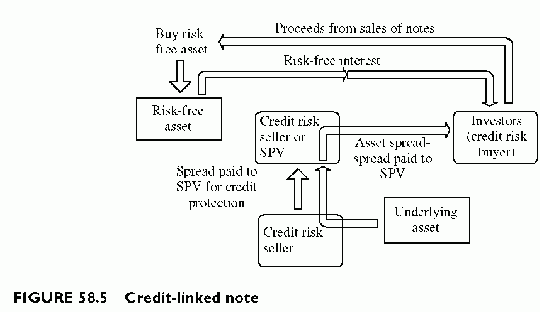CREDIT-LINKED NOTES
Category: Risk Management in Banking
A Credit-Linked Note (CLN) is like a credit derivative. It is a debt with payments linked to the performance of assets. Notes are tradable in the market. Being liquid is a major benefit. Protection buyers dislike looking for investors directly. They prefer to have something traded. CLNs meet this requirement. In order to be tradable, the note needs some special features providing comfort to investors.
The first stage of the structure is a classical default swap, between a highly rated entity providing the insurance and a bank looking for a protection. The protection buyer pays a fee to the entity. The entity selling the protection needs a high rating because it issues the notes to investors, who ultimately bear the credit risk. Alternatively, the issuer of the CLN is a Special Purpose Vehicle (SPV). However, the SPV has no credit standing as such, and it remains necessary to provide investors and the credit risk seller with some payment guarantee.
The SPV issues notes to investors and invests the proceeds from the sale in risk-free assets. These risk-free assets serve both as collateral and to pay the risk-free interest to investors. If investors buy highly rated notes directly, they will not get any excess return. However, since the SPV sold a protection, this enhances the return to investors with the revenues from the sale of the protection. In essence, the process breaks down a risky return into a risk-free interest plus the fees from the protection sale. The investors in the SPV get an enhanced return because of this sale. The credit risk seller pays a spread to the SPV. The excess of the asset spread over the spread paid to the SPV is the excess return to investors (Figure 58.5).
If there is no default event of the reference asset, the structure lives up to maturity, with the third party protected and the return to investors enhanced by the sale of protection by the SPV to the third party. Finally, at maturity, the SPV pays the face value of the asset to investors from the purchased risk-free collateral. If there is a default event, the SPV pays the amount lost, that is the face value of the asset minus recoveries to the buyer of protection and the investors get the recoveries only. The SPV total payment is the same as under no default, since it pays both the recoveries and the loss. Only the recovery fraction goes to investors, because the SPV provides protection to the third party first and because investors agreed to provide the insurance. The buyer of protection does not face the credit risk of investors, and that investors have their principal payments collateralized by risk-free assets, to the extent that there is no default. Investors fund from the very beginning whatever payments are due to both the risk protection buyer and themselves by purchasing the SPV notes. The SPV is capable of facing both obligations. In the end, all parties get some share of the value added of the CLN.
CLN can leverage the return of assets if they have a value lower than the value of assets. If the assets total 100 million USD and the note is 20 million USD, the leverage is 5. If the loss exceeds 20 million, the investors absorb a loss of 20 and the bank absorbs the excess loss beyond 20.

